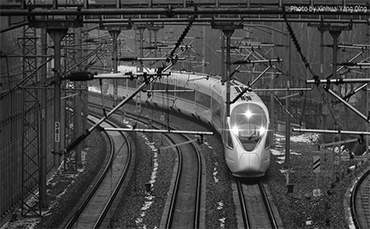



▲ A bullet train leaves Shenyang North Railway Station in Shenyang, Liaoning province, for Beijing on Jan 22. [XINHUA/ YANG QING]
China has unveiled a high-profile planning outline on developing comprehensive transport network with the aim of building a modern and more convenient national transportation network by 2035.
The outline, which was jointly released on Feb. 24, 2021 by the Communist Party of China Central Committee and the State Council, set the long-term goal of building the country's strength in the transport sector over the next 15 years, allowing most residents to have access to a national highway within 15 minutes, a freeway in half an hour and a railway in an hour.
According to the outline, by 2035, the developing aims including as follows:
The country's transport network should be convenient, cost-effective, green, intelligent and safe;
The transport network should feature higher domestic and international connectivity, multi-channel access to major cities, and effective coverage of county-level regional nodes;
China should be at the global forefront in terms of the quality, intelligence and green levels of transport infrastructure;
By the middle of the century, a modern, high-quality and comprehensive national transport network will be built in an all-round way, with a world-class transport infrastructure system.
Based on the level of transportation demand, China will work to build a national comprehensive transport-hub system that divides geographic regions into three categories: the highest level is "pole regions", the medium level is "cluster regions", and the lowest level is "group regions".
There are four "pole regions"--the Beijing-Tianjin-Hebei region, the Yangtze River Delta economic region, the Guangdong-Hong Kong-Macao Greater Bay Area and the Chengdu-Chongqing economic circle, in addition to eight "cluster regions" and nine "group regions".
An international transportation network will be established, including international freight trains, four ocean transport lines, and a flight and logistics network with global access.
The length of China's high-speed railways, freeways and urban rail networks all already rank top in the world. The railway network, excluding urban rail, has reached 146,300 km, with about 38,000 km of high-speed railway lines. The road network has reached 5.2 million km, with 161,000 km of expressways.
Amid efforts to optimize the country's comprehensive transport layout, the total scale of the national comprehensive transport network will reach about 700,000 km by 2035, excluding the mileage of overseas sections of international land passages, air and sea routes and logistics routes.
Among them, there will be about 200,000 km of railways, 460,000 km of highways and 25,000 km of high-grade waterways, with 27 major coastal ports, 36 major inland ports, about 400 civil-transport airports and about 80 logistics hubs, the outline said.
Calling for further integrated development of transportation with other industries, the outline also stressed efforts to empower transport infrastructure with new technologies and coordinate the development of intelligent connected vehicles and smart cities.
Source: Xinhua & China Daily
Edited by Guo Xinxin